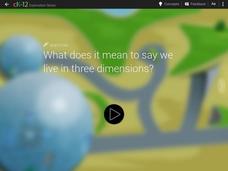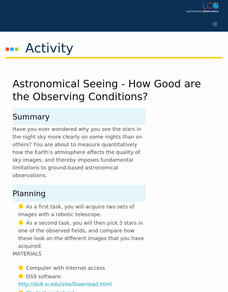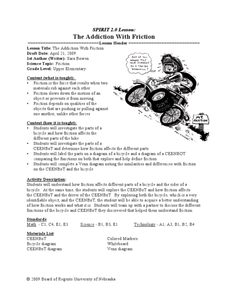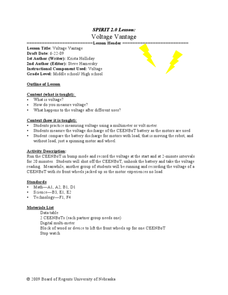CK-12 Foundation
Irwin 2D
Learners explore two-dimensional motion through visual modeling with an interactive lesson that allows them to control the path of a robot. Graphs show both the horizontal and vertical motion as the robot continues through its...
CK-12 Foundation
Irwin and Ruthie
Learners compare acceleration to displacement through an interactive tutorial that permits them to adjust the running strategy of two robots and watch them race. A graph displays the robot's velocity over time and another shows their...
Scholastic
Falling Stars
Young scientists explore meteors, and comets by reading a fascinating passage in the plan, then answering 13 questions about them. Then, learners perform a WebQuest and learn amazing things about gravity, robots, and black holes. The...
Las Cumbres Observatory
Astronomical Seeing - How Good Are the Observing Conditions?
Why is star gazing easy on some nights and difficult on others? Pupils aim to quantify the answer in an enlightening astronomy lesson. After collecting images from an online robotic telescope, they measure the brightness of images using...
Curated OER
Lego Robotics: Measuring Speed
Students build and program a LEGO robotic car as well as measure and graph its speed. They acquire familiarity with principles of construction, motion, design and problem solving. They compare a robot's speed over two different surfaces...
Curated OER
The Robot Artist--Aaron
This is a creative multidisciplinary instructional activity which will involve young scholars in art, technology, and psychology. Students learn about Harold Cohen who created a robot programmed to create art. Young scholars will also...
Curated OER
Robots Alive: Almost Human
Students explore robotics. They design and draw a robot to fit a specified function. Students examine motor functions necessary for the robot to perform. They discuss types of sensors available to assist in the building of a robot.
Curated OER
The Cassini Robot
Young scholars compare the functions of a robot to that of the human body. In this technology lesson plan, students identify the important components of the Cassini robot that would enable it to carry out space missions. They design and...
Curated OER
Robot Turning Lab
Students design a robot that can turn 90 degrees. In this robotics instructional activity, students explain the applications of their invention. They present their design in class.
Curated OER
Robot Labyrinth
Young scholars design a flowchart for their robotic program. In this physics instructional activity, students construct a robot that can navigate certain obstacles. They present their program and robots in class.
Curated OER
Robot Olympics
Pupils design a robot based on given requirements. In this technology lesson, student test whether their robots can perform certain tasks. They present and discuss their program design.
Curated OER
24 Hour Party Robots
Learners read an article about robots and social behavior. As a class, they write down new vocabulary words they are unfamilar with in the article. In groups, they discover what all the words have in commom and identify the type of...
Curated OER
Robot Gears
Learners build simple gear trains and record data to discover how to compute gear ratios. They investigate the definition of torque and how torque can be increased or decreased in a gear train.
Curated OER
The Importance of Detailed Procedures in Science
Students examine the importance of clear communication in scientific exploration. In pairs, they write clear directions for an everyday activity for their partner to read and follow.
National Center for Case Study Teaching in Science
To Boldly Go, or Not
Here is a different way to combine social studies and science. Have your high schoolers read a passage about the 2004 vision for space exploration and then discuss the practicality, costs, and reasons for returning to the moon. Then, the...
Curated OER
Cell Me What?
Students compare and contrast the characteristics of robots and cells. In this biology activity, students examine the parts and function of cell organelles. They create a visual representation of their cell/robot analogy.
Curated OER
The Addiction With Friction
Students compare and contrast where friction occurs in robots and bicycles. In this science lesson, students label the diagram of bicycle and robots. They investigate how friction affects their different parts.
Curated OER
Voltage Vantage
Students measure the voltage discharge of robots as the motors are used. In this physics lesson plan, students explain how to use a multimeter to measure voltage. They graph the voltage change over time and present their findings in...
Curated OER
Normal (dip-slip) Earthquake!
Students label the fault lines and tectonic plate boundaries on the world map. In this earth science lesson, students simulate ocean floor formation using CEENboTs. They explain the causes of earthquakes.
Curated OER
Journey to the Center of a Cell
Ninth graders create a large scale model of a eukaryotic cell. In this biology lesson, 9th graders identify the different parts and function of the cells by using a robot to navigate through the cell models. They create a video tutorial...
Curated OER
Science Fair Projects
Coming up with ideas for Science Fair projects might seem daunting, but there are many lessons that can get students on the right track.
NASA
Beginning Engineering, Science, and Technology
Space, the Final Frontier. The nine NASA-created challenges in this unit are designed to teach class members the engineering design process. Each challenge comes with teacher and student pages that can be used individually or as a...
Messenger Education
Mission: Possible—How Can We Plan an Exploration of Another World?
An astronaut's spacesuit weighs 280 pounds and takes 45 minutes to put on — that's a serious suit! The second activity of a three-part series allows pupils to see all that goes into space exploration. Through simulations, groups analyze...
Curated OER
Design Team Challenge
Students work in groups to build a robot. In this robotics lesson, students create an electronic robot and program it to follow directions. They create an obstacle course for the robot to follow and test its performance.























